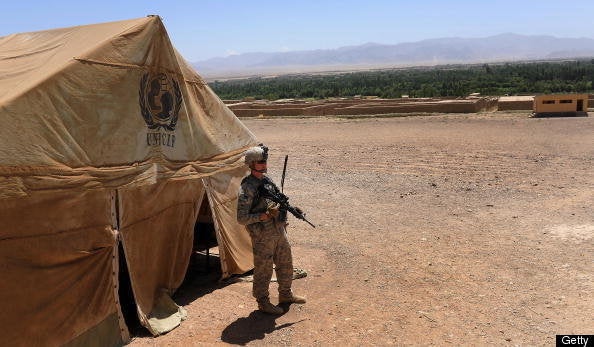
The delivery of a status report from the commander of Allied forces in Afghanistan, Lt. General Stanley McChrystal, is certain to rekindle a debate about the objectives, resource requirements, and duration of US involvement. After eight years in Afghanistan it's unclear what we are fighting for.
There are four interlocking US objectives that can be regarded as concentric circles having different degrees of specificity. The original objective, the inner circle, has the clearest definition: apprehend those who planned the attacks on September 11, 2001. US forces went into Afghanistan to track down Osama bin Laden, Ayman al-Zawahiri, and the other top Al Qaeda leaders.
While most Americans viscerally support this objective, time has eroded its attraction. Most experts believe the Al Qaeda 9/11 planners fled Afghanistan, in late 2001, and since then have been hiding in the Federally Administered Tribal Areas of Pakistan. Moreover, the original leaders may have "retired." Since September 7, 2007, no videotapes have been received from bin Laden; while there have been more recent audiotapes, some observers believe he is dead. There is stronger evidence that al-Zawahiri is alive; nonetheless, a year ago there were reports that he had been severely injured in a missile strike.
It is increasingly unlikely that there will be a show trial featuring bin Laden, al-Zawahiri, and their cronies. While US forces should keep looking for them, this is no longer our primary reason for being in Afghanistan.
From the onset, there has been a related US objective, the second circle: deny Al Qaeda a safe haven. Al Qaeda had camps in Afghanistan and US forces destroyed them.
However, after the poorly executed Bush Administration invasion of Afghanistan, many Al Qaeda terrorists took refuge in northwest Pakistan. So did the Afghan leaders of the Taliban, who had provided sanctuary for Al Qaeda. Over the course of the next few years, the distinction blurred between Al Qaeda, the Taliban - originally Pashtun Sunni Islamists - and militants with other agendas. More importantly, Al Qaeda's focus shifted to destabilizing Pakistan and gaining control of its nuclear weapons.
After several years of ineffective operations sponsored by the Bush and Musharraf Administrations, President Obama cajoled current Pakistani President Zardari to go after the Al Qaeda/Taliban sanctuaries. In April the Pakistani Army initiated a major initiative against the Taliban and Al Qaeda. At the same time, the scope of US operations widened from denying Al Qaeda a safe haven in Afghanistan to battling Al Qaeda and the Taliban in Afghanistan and Pakistan.
As a result there was a new, third US objective, the next concentric circle, to prevent the Taliban from retaking control of large sections of Afghanistan. During its years in exile, the Taliban has grown stronger, threatened to destabilize northwestern Pakistan and seized control of 40 percent of Afghanistan. The Obama Administration believes that if the Taliban thrives, Al Qaeda will benefit, and Afghanistan and Pakistan will be imperiled.
There are three problems with this objective. The first is that the "Taliban" has become an amorphous term that includes not only members of the Afghan group that ruled from 1996 to 2001 but also Al Qaeda-led jihadis, warlords, thugs, drug dealers, and gun-carrying locals who don't like Americans. The operational definition of our enemy has shifted from "terrorists" to "Islamic militants."
The second problem is that expanding the focus to include the Taliban means that the scope of the effort has broadened to include all of Afghanistan and much of Pakistan - an area as large as the southwestern US.
The third problem is that when Al Qaeda and the Taliban combined forces they began to receive funding from the Afghan opium trade - worth $3 billion a year. Thus, the US cannot curtail the resurgent Taliban or Al Qaeda until we find a way to curtail regional drug trafficking.
The fourth US objective, the outer circle, is the most nebulous: provide Afghanistan with a stable government. In 2001, after the Taliban government refused to hand over bin Laden and the other Al Qaeda leaders, the US invaded Afghanistan and set up an alternative government that eventually came to be run by the present President, Hamid Karzai. For both historical reasons and Karzai's limitations, the prospects for Afghan democracy seem bleak. Therefore, an operation definition of "stable government" remains elusive.
It's clear that of these four objectives only the third, prevent the Taliban from retaking control of a large sections for Afghanistan, is worth further expenditure of American lives and resources. The US is fighting in Afghanistan to prevent the Taliban - Islamic militants - from making a comeback, because if they do it will strengthen Al Qaeda and fatally weaken Pakistan, a nuclear state.
Going forward the US mission should have three goals. First, join with the Afghan and Pakistani armies to destroy Al Qaeda/Taliban camps and suppliers. Second, curtail opium cultivation. Third, provide enough security in Afghanistan so that locals will be motivated to join us to fight the Taliban.
